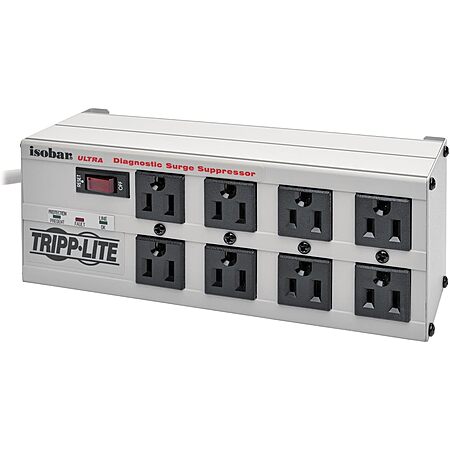Update: This deal is still available and with a slightly lower price.
Amazon has
Tripp Lite Isobar Ultra 8-Outlet Surge Protector Power Strip w/ 12' Cord on sale for $54.92 ->
Now $54.41.
Shipping is free.
Walmart also has
Tripp Lite Isobar Ultra 8-Outlet Surge Protector Power Strip w/ 12' Cord on sale for $54.92 ->
Now $54.41..
Shipping is free.
Thanks to community member
jmabi for finding this deal.
Product Details:
- 3840-joule surge protection rating
- EMI/RFI noise filtering protects against outside interference
- Isolated filter banks protect against internal interference
- 12-foot AC input cord with 5-15P right-angle plug




Leave a Comment
Top Comments
on some glorified surge protector, you may as well buy a;
https://www.amazon.com//dp/B00009RA60
line conditioner, which is superior to ANY surge suppressor
as it also adds brown out protect which is very common.
these will remain effective forever, while surge protectors
lose their their rating over the years. i bought this 600w
https://www.youtube.com/watch?v=29MBmnG
30 years ago for $100 and it's been flawless ever since,
protecting all my home network and AV equipment.
Additionally, as MOVs (the surge protection component) wear out, the clamping voltage drops. If/when the clamping voltage drops below the peaks of the sine wave, it will start clamping when there is not a surge, leading to a positive feedback loop and thermal runaway. This is one of the reasons surge protectors sometimes catch fire. Modern surge protectors are required to have thermal fuses, to reduce the likelihood of this. The point is, all else being equal, a MOV with a lower clamping voltage will fail quicker than one with a higher clamping voltage. It will both be suppressing milder surges and have less room for degradation before failure.
As you brought up, the clamping voltage (and joule rating) can also be different between legs. Unlike hot-neutral and hot-ground, neutral-ground should have less/no difference in potential between them (0V). This is not always the case, especially in improperly wired circuits. The level of protection provided does often differ between the various legs. Surges are less likely neutral-ground, so there's usually less protection there. Hot-neutral and hot-ground are the bigger concern.
As for the product you linked, it looks like a slightly lower end unit. It doesn't appear to be of their flagship Isobar/Isotel line. It lacks the isolated filter banks and metal casing. It may also have weaker surge protection. It does have RJ11 (telephone) protection but not many people still have conventional landlines. I would spend the extra on the Isobar in this deal.
People often overestimate what a line conditioner or UPS does, probably due to good marketing. A line conditioner is usually simply a mediocre surge protector combined with a 2 or 4 stage AVR. As demonstrated in that video, that model has 4 discrete AVR modes (2 boost and 2 buck). This will boost or trim the incoming voltage by a certain percentage. As he shows, it does NOT guarantee a constant 120V. An AVR is really only useful if use experience frequent, prolonged mild/moderate undervoltages or overvoltages and have equipment that is sensitive to them. Many modern switching power supplies are already designed to accept voltages in this range. I don't think line conditioners are particularly useful for the average person. Depending on your needs, a good surge protector or a UPS is likely a better choice.
Unless they've changed, the Tripp-Lite Isobar Ultra is a high quality point-of-use surge protector. Like most other surge protectors you see for sale, it does use sacrificial MOVs that WILL eventually fail (even if it takes decades). If you want something that should last forever, you need to shell out big money for a series mode surge protector. Those are uncommon and expensive (I think about $200 for the most basic model).
For protection from surges originating from outside the house, a whole-house surge protector is the best choice. These provide far superior protection, due to their proximity to earth ground. Point-of-use surge protectors are still a good idea for surges originating inside the house.
If you're going to do that, it would be preferable to do it the other way around. Plug the power conditioner into the surge protector.
95 Comments
Sign up for a Slickdeals account to remove this ad.
Our community has rated this post as helpful. If you agree, why not thank doctorwizz
Our community has rated this post as helpful. If you agree, why not thank PetSpy
on some glorified surge protector, you may as well buy a;
https://www.amazon.com//dp/B00009RA60
line conditioner, which is superior to ANY surge suppressor
as it also adds brown out protect which is very common.
these will remain effective forever, while surge protectors
lose their their rating over the years. i bought this 600w
https://www.youtube.com/watch?v=29MBmnG
30 years ago for $100 and it's been flawless ever since,
protecting all my home network and AV equipment.
Sign up for a Slickdeals account to remove this ad.
on some glorified surge protector, you may as well buy a;
https://www.amazon.com//dp/B00009RA60
line conditioner, which is superior to ANY surge suppressor
as it also adds brown out protect which is very common.
these will remain effective forever, while surge protectors
lose their their rating over the years. i bought this 600w
https://www.youtube.com/watch?v=29MBmnG
30 years ago for $100 and it's been flawless ever since,
protecting all my home network and AV equipment.
on some glorified surge protector, you may as well buy a;
https://www.amazon.com//dp/B00009RA60
line conditioner, which is superior to ANY surge suppressor
as it also adds brown out protect which is very common.
these will remain effective forever, while surge protectors
lose their their rating over the years. i bought this 600w
https://www.youtube.com/watch?v=29MBmnG
30 years ago for $100 and it's been flawless ever since,
protecting all my home network and AV equipment.
you can plug anything into the line conditioner as long as
it's not a heating element or high amp motor, so you do
NOT plug a laser printer into this thing.
i just use plain power strips to add outlets to my line
conditioner, because using surge protectors is pointless.
the voltage dip of my fridge, AC and laser printer start up motor.
I'm also trying to understand the protection difference between this and another tripp lite TLP1208TEL: https://www.amazon.com/dp/B0036FS...dp_it
Sign up for a Slickdeals account to remove this ad.
Kasonic 8 inch Short Power Extension Cord Outlet Saver, ETL Listed, SJTW 16AWG/13A 3 Prong Indoor/Outdoor Use, 4 Pack, Black https://www.amazon.com/dp/B09HSR3T8D
Leave a Comment